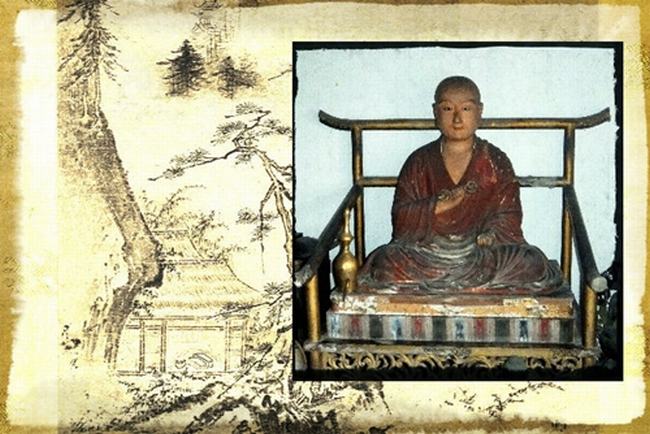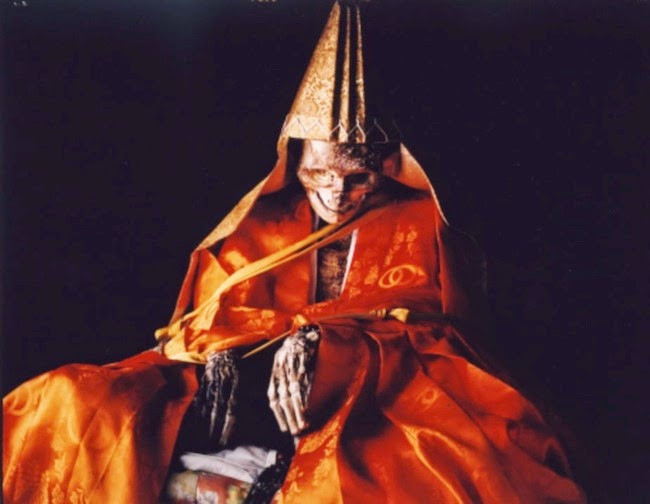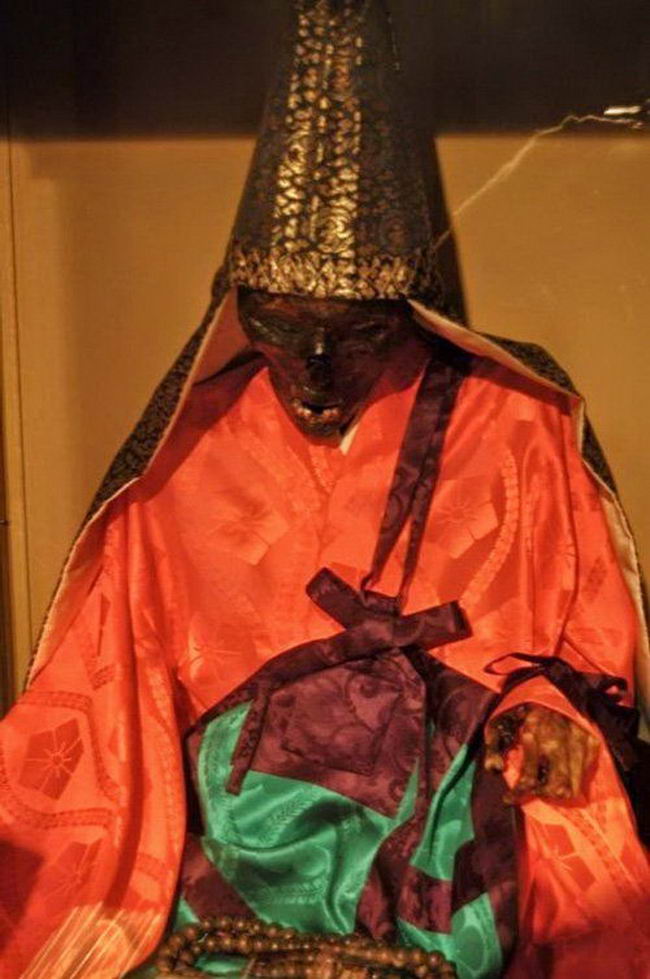Hero the process of self-mummification on the living of Japanese monks
To be able to self-mummify, Japanese monks in ancient times underwent harsh cultivation and eating regimes that lasted for a decade. They consider it a form of enlightenment. After death, their bodies are fully preserved.
- 7 horrifying facts about ancient mummies
- Discover the mysterious mummification process of the ancient Egyptians

More than 1,000 years ago, the art of self-embalming was invented by a Japanese monk Kukai. He mummified himself in the temple on Mount Koya, Wakayama Prefecture. When excavated, experts discovered the monk's body was like a sleeping person, his skin was unchanged and his hair grew longer.
Kukai (774-835) is a monk, scholar, poet, and artist, and the founder of the Shingon esoteric sect. This denomination combines elements from Buddhism, Shinto, Taoism, . and gives theories of enlightenment through corporal punishment.
The process of self-embalming lasts more than 3000 days, consists of 3 main stages with strict steps and suffering a lot of pain.
The first 1000 days, is the stage to reduce the amount of fat and meat in the body. This is the main cause of decomposition in mummies. In the first stage, monks have to make a special diet of nuts and fruits such as peanuts, soybeans, wild berries . and perform many physical activities with great intensity to push substances. fat out of the body. After going through this stage, the monks were only skin and bones, maintaining a weak life.

At that time, the monks will move on to the next stage, lasting another 1000 days. At this stage, their food intake drops to the lowest possible level, eating only bark and roots. The amount of water in their bodies gradually depleted.
In the last 1,000 days, monks will drink poisonous tea made from Urushi resin, causing vomiting and quickly losing body fluids. At the same time, poison in tea also acts as a preservative, limiting bacteria that can decompose the body.
After the end of the "death" process, which lasted for about 6 years, the monks locked themselves in a monolithic tomb just a little bigger than the body and went into a state of meditation, in a sitting posture. "lotus" meditation until death. The grave door will be sealed, only a small air duct for air circulation.
Every day, the monk will vibrate a bell to bring to the grave so everyone outside knows he is still alive. When the bell rang, meaning the monk was dead, the air duct was sealed.

1000 days later, the grave will be opened to check whether the mummification is successful. If successful, the monk will be honored as Buddha and worship in the temple. Conversely, if the body is decomposed, they will be buried in the ground carefully.
Of the hundreds of monks thought to have embalmed themselves, only 28 succeeded. By the 19th century, the self-embalming method had completely ended in Japan.
You should read it
- Special salt used by Egypt to help the school mummies survive for thousands of years
- Discovering another 'super Earth' can appear to live only 21 light-years away
- Horror cases of living with corpses
- A few reviews of Japanese goods 2 old Japanese goods, Japanese goods
- 16 lessons that changed lives after only one year living in Japan
- This is the difference between a positive and a negative person
- This is why Japanese people often do not lean on their seats when flying
- 20+ images of the secret behind the lives of Japanese businessmen
May be interested
- [Review] Should I buy a GoPro Hero 7 Black camera? Detailed user guide
![[Review] Should I buy a GoPro Hero 7 Black camera? Detailed user guide](https://tipsmake.com/img/no-image-80-80.png) what is special about gopro hero 7 black camera? is it suitable for use on backpacking trips? how to use the details? all will be answered through the following summary
what is special about gopro hero 7 black camera? is it suitable for use on backpacking trips? how to use the details? all will be answered through the following summary - Tips for playing My Hero Academia: The Strongest Hero
 tips to play my hero academia: the strongest hero, tips to play my hero academia: the strongest hero to quickly become a powerful hero,
tips to play my hero academia: the strongest hero, tips to play my hero academia: the strongest hero to quickly become a powerful hero, - What kind of Japanese annealing pot is worth buying today?
 possessing outstanding advantages, japanese incubator is gaining a lot of love from vietnamese users. so do you know the best japanese brewer?
possessing outstanding advantages, japanese incubator is gaining a lot of love from vietnamese users. so do you know the best japanese brewer? - 16 lessons that changed lives after only one year living in Japan
 no one returned to their country as their own. each trip will give us a new look and return to life lessons - it is the american journalist amy chavez after a year living in japan. here are 16 life-changing lessons after only one year living in japan
no one returned to their country as their own. each trip will give us a new look and return to life lessons - it is the american journalist amy chavez after a year living in japan. here are 16 life-changing lessons after only one year living in japan - Life is amazing: The process of transforming from a living cell to a perfect living organism in just 6 minutes
 find out how wonderful life is when a complete living organism is formed only from a single cell.
find out how wonderful life is when a complete living organism is formed only from a single cell. - 5 interesting things about the Japanese education system make the whole world jealous
 considering the more personality education of the academic results, standardized lunches or the students cleaning the classroom without labor is the impressive things you see in japanese schools.
considering the more personality education of the academic results, standardized lunches or the students cleaning the classroom without labor is the impressive things you see in japanese schools. - TOP strongest skulls in Skul: The Hero Slayer
 skul: the hero slayer is a roguelike game with thrilling and innovative pixel graphics, with lots of fascinating content for players to explore.
skul: the hero slayer is a roguelike game with thrilling and innovative pixel graphics, with lots of fascinating content for players to explore. - Japanese Walking: This Gentle Exercise Can Give You a Healthier Heart
 japanese-style walking, iwt, was developed by japanese researchers to improve the cardiometabolic health of older adults.
japanese-style walking, iwt, was developed by japanese researchers to improve the cardiometabolic health of older adults. - Review One Punch Man: A Hero Nobody Knows - A fighting game about Saint Bong Tom
 despite possessing a tremendous appeal to longtime anime fans, can one punch man: a hero nobody knows still be able to hold its ground against countless other fighting games on the market?
despite possessing a tremendous appeal to longtime anime fans, can one punch man: a hero nobody knows still be able to hold its ground against countless other fighting games on the market? - 12 meals causing fever to social networks of postpartum women at Japanese hospital
 we invite you to take a look at the 12 meals that make your social network postpartum pregnant at japanese hospital in the article below!
we invite you to take a look at the 12 meals that make your social network postpartum pregnant at japanese hospital in the article below!
![[Review] Should I buy a GoPro Hero 7 Black camera? Detailed user guide](https://tipsmake.com/data/thumbs_80x80/[review]-should-i-buy-a-gopro-hero-7-black-camera-detailed-user-guide_thumbs_80x80_cQ4ltEWXW.jpg)









 Why hot water freezes faster than cold water
Why hot water freezes faster than cold water How will a meteorite be found to crash into NASA Earth?
How will a meteorite be found to crash into NASA Earth? The non-electric 'refrigerator' especially in Africa can be as cold as 6 degrees Celsius
The non-electric 'refrigerator' especially in Africa can be as cold as 6 degrees Celsius Without the summer, humans did not appear, the Giza pyramid was not built and there was no war of scale like today.
Without the summer, humans did not appear, the Giza pyramid was not built and there was no war of scale like today. The tribe has only 5 members in the middle of the dense forest in danger of extinction
The tribe has only 5 members in the middle of the dense forest in danger of extinction Terrifying scenario if the Earth lost oxygen in 5 seconds?
Terrifying scenario if the Earth lost oxygen in 5 seconds?